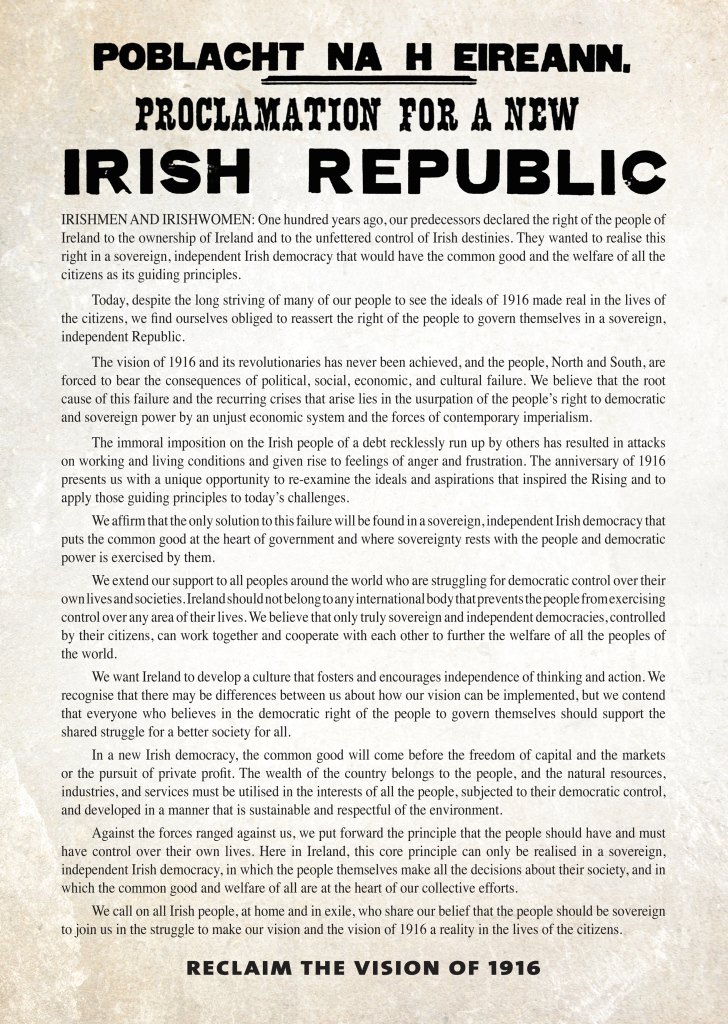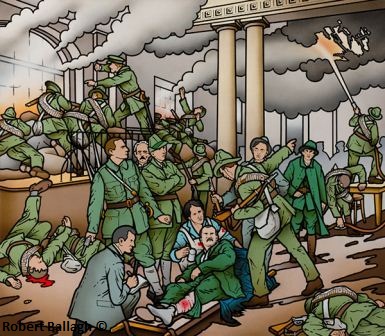
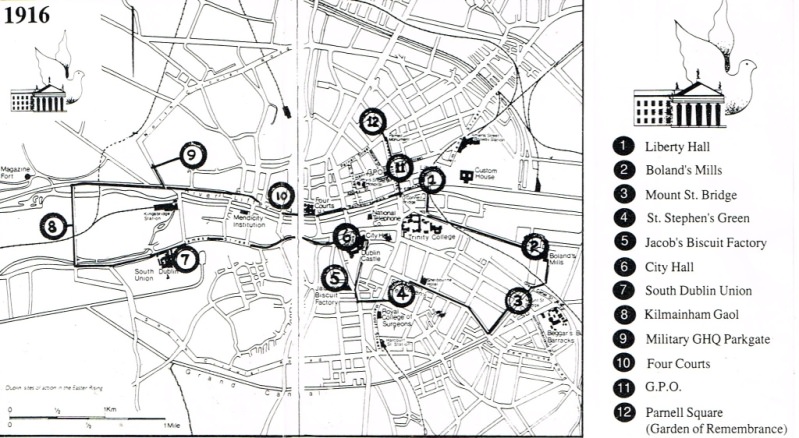
The original cassette inlay from 1991.
Fáilte, Welcome, Bienvenue, Bienvenidos, Bem-vindo, Willkommen, Mile Widziany, ようこそ , 欢迎 ,
The one-hour recording can be heard/read as a conducted tour of the outposts in Dublin where the insurgents of Easter week 1916 held out against the superior forces of the British Empire from the declaration of the Irish Republic at midday on the Monday to the final surrender on the Saturday. The listener/reader can undertake the walk from Liberty Hall to Boland's Mill, Stephen's Green, the YMCA building (formerly Jacob's Factory), Dublin Castle and along the Quays to St. James' Hospital (formerly South Dublin Union), the Four Courts, the G.P.O. and end in Parnell Square at the Garden of Remembrance, but the recording itself with the narration, the music, the songs and poetry, is of itself good listening without essaying the walk at all.
Is féidir éisteacht leis an taifeadadh uair an chloig, nó é a léamh, mar thuras treoraithe ar na hurphoist i mBaile Átha Cliath inar sheas ceannaircigh Sheachtain na Cásca 1916 an fód in aghaidh fhórsaí ceannasacha Impireacht na Breataine, ó fhógairt Phoblacht na hÉireann ag meán lae ar an Luan, go dtí an géilleadh deiridh ar an Satharn. Tig leis an éisteoir/léitheoir an tsiúlóid a dhéanamh ó Halla na Saoirse go Muileann Uí Bheoláin, Faiche Stiabhna, foirgneamh an YMCA (iarmhonarcha Jacob), Caisleán Bhaile Átha Cliath, agus ar feadh na gcéanna chuig Ospidéal San Séamas (iar-Aontas Bhaile Átha Cliath Theas), na Ceithre Chúirt, Ard-Oifig an Phoist, go dtí an ceann scríbe ag an nGairdín Cuimhneacháin i gCearnóg Parnell; ach is lón maith éisteachta an taifeadadh féin, gona aithris, ceol, amhráin agus filíocht, gan tabhairt faoin turas in aon chor.
The extracts of Tomás MacAnna's handwritten script are reproduced here in honour of one of Ireland's greatest believers in Irish heritage, language and folklore. His commitment to the Abbey Theatre was unstinting, his contribution incalculable and his handwriting was always a delight to read
Tá na sleachta de script lámhscríofa Thomáis MhicAnna san áireamh anseo in ómós do dhuine de na daoine ba mhó in Éirinn a chreid in oidhreacht, teanga agus béaloideas na hÉireann. Bhí tiomantas iomlán aige d’Amharclann na Mainistreach, rinne sé cion oibre thar na bearta, agus ba mhór an sásamh i gcónaí a lámhscríbhneoireacht a léamh.
First page of Tomás MacAnna's handwritten script
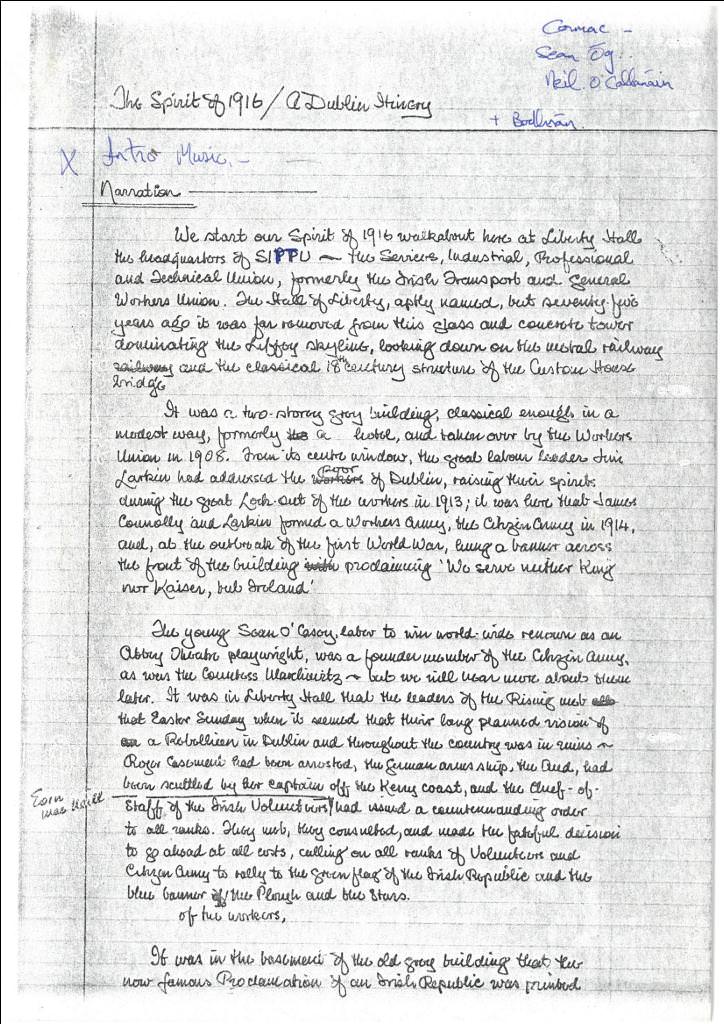
Page 17 of Tomás MacAnna's handwritten script
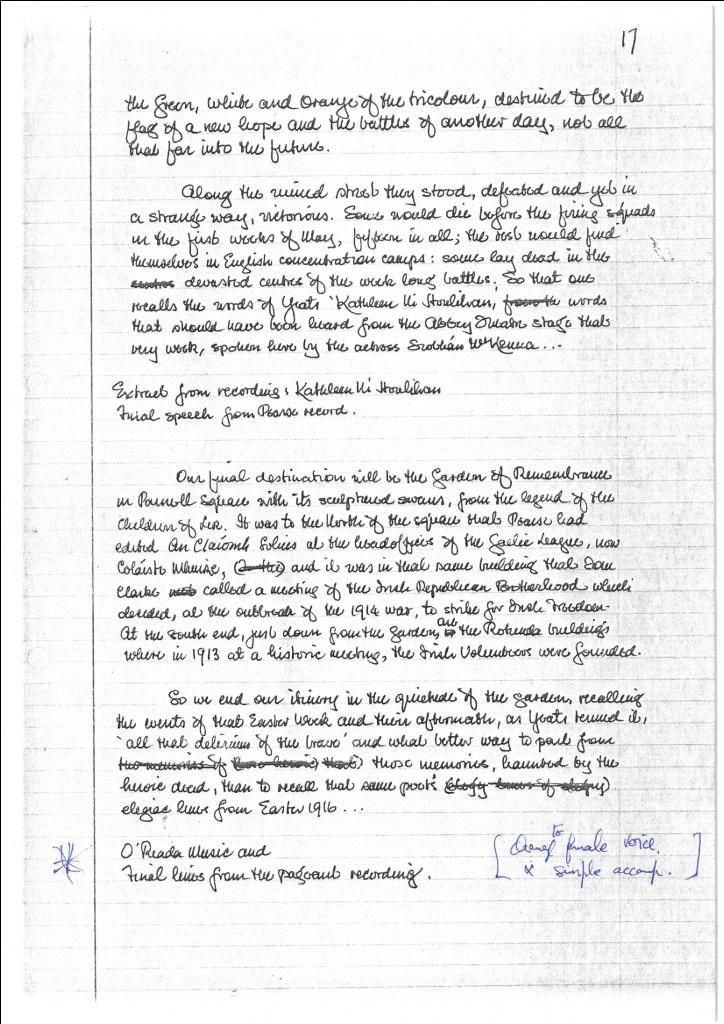
Click on the flags to access photographs and audio commentaries.
Cliceáil ar na bratacha chun teacht ar na grianghraif agus na tráchtaireachtaí.
Click on the outposts in order to access photographs and commentary.
Cliceáil ar na hurphoist chun teacht ar na grianghraif agus na tráchtaireachtaí.
The application will take you on a tour of Dublin with audio commentaries, music, songs and poetry about the 1916 Easter Rising.
The tour starts in Liberty Hall and ends in The Garden of Remembrance in Parnell Square. You can take the tour using either the online version or the offline version.
Go back to the main menu, by pressing the "Main menu" button located at the top of the screen, and press "Start the Tour (online version) ". A map of Dublin will appear on your screen with the 12 stages marked with little flags. Please note that the starting point (Liberty Hall) will be represented by  . All the other outposts are highlighted by a little Irish flag
. All the other outposts are highlighted by a little Irish flag  . If the map does not display, please make sure your device is 3G or 4G enabled and connected to Internet (through a data network or WIFI). If you cannot get your device to connect to the Internet, then please use the offline version.
. If the map does not display, please make sure your device is 3G or 4G enabled and connected to Internet (through a data network or WIFI). If you cannot get your device to connect to the Internet, then please use the offline version.
Go back to the main menu, by pressing the "Main menu" button located at the top of the screen, and press "Start the Tour (offline version) ". A list of the 12 outposts will dislay on your screen, just press the outpost relevant to your location.
On each outpost's page, you will see a slideshow of photographs of your surroundings, comparing them to what they looked like back in 1916. To hear the commentary by Donncha Ó Dúlaing, press the "play" button on the audio panel. Below the audio panel, you will find the transcript of the commentary.
At any point, you can use the navigation bar located at the top and/or bottom of the screen to get back to the map, to the list of outposts or to the main menu.
The objectives of the Association have always been:
To restore, where necessary, and maintain fittingly the graves and memorials of our patriot dead of every generation.
To commemorate those who died in the cause of Irish freedom.
To compile a record of such graves and memorials
The mission of the National Library of Ireland is 'To collect, preserve, promote and make accessible the documentary and intellectual record of the life of Ireland and to contribute to the provision of access to the larger universe of recorded knowledge'.
Prison museum where many of Ireland's political prisoners were incarcerated, tortured and executed.
Address: Inchicore Rd, Kilmainham, Dublin 8, Ireland
Victorian burial grounds & museum with guided tours, interactive exhibits, a gift shop & cafe.
Address: Finglas Rd, Dublin 11, Ireland
Collins Barracks is a former military barracks in the Arbour Hill area of Dublin, Ireland. The buildings are now the National Museum of Ireland – Decorative Arts and History.
The archives contain the records of the Order of Friars Minor Capuchin in Ireland from 1615 to circa 1980. Principal collections include Correspondence and papers of Fr. Albert Biddy, OFM Cap., Fr. Dominic O'Connor, OFM Cap., and other Capuchins involved in ministering to court-martialed insurgent leaders following the Easter Rising. This collection includes contemporary republican pamphlets, newspapers, handbills, photographs, correspondence and other documents relating to the War of Independence, the Treaty and the Civil War.
"Courage Boys We Are Winning – An Illustrated History of the 1916 Rising" by Michael Barry (Andalus Press 2015)
"Deansgrange Cemetery & The Easter Rising" by Ray Bateson, published by Irish Graves Publications October 2015
"To Speak Of Easter Week - Family Memories of the Irish Revolution" by Hélène O'Keefe (Mercier Press)
"Easter Widows - Seven Irish Women who lived in the Shadow of the 1916 Rising" by Sinead McCoole (Doubleday Ireland)
"A Pictorial Guide, The Easter Rising" published by Picture Press
"Easter Dawn: The 1916 Rising" by Turtle Bunbury (Mercier Press)
1916 Rebellion Walking Tour
More information here.
Dublin Political History Tours
More information here.
| Narrator |
Donncha Ó Dúlaing |
| Scriptwriter + Producer |
Tomás MacAnna |
| Poetry Readers |
Bosco Hogan, Eithne Dempsey |
| Musical Director |
Gerard Keenan |
| Musicians |
Cormac Breatnach (flute + low whistle) Niall Ó Callanáin (acoustic and electric bouzouki) Seán Óg Potts (uilleann pipes) |
| Vocalist |
Joan McDermott |
Recorded at STARC Studio, Dublin.
Engineer – Ken Harley.
Sound Recording © 1991 c/o Cormac Breatnach
This recording under the then banner of
Reclaim the Spirit of Easter 1916/A Dublin Itinerary was supported by Dublin 1991 Cultural Capital of Europe.
The copyright in the audio recording incorporated in this App is held by the Estate of Tomás MacAnna.
| Mo Ghile Mear |
arr by Cormac Breatnach, Séan Óg Potts and Niall Ó Callanáin |
| Fanny Power |
arr by Cormac Breatnach, Séan Óg Potts and Niall Ó Callanáin |
| The Ballad of James Connolly |
arr by Joan McDermott |
| Bold Robert Emmet |
arr by Joan McDermott |
| The Dublin Reel |
arr by Séan Óg Potts and Niall Ó Callanáin |
| The Lament for Limerick |
arr by Cormac Breatnach |
| The Women of Ireland |
arr by Cormac Breatnach and Niall Ó Callanáin (composed by Seán Ó Riada) |
| Dear Irish Boy |
arr by Séan Óg Potts |
| App Icon and Print |
Robert Ballagh |
| App Design and Co-Direction |
Emmanuelle Balme - Emma B. Designs |
| App vintage photographs |
(a) Irish Capuchin Provincial Archives(Visit website) (b) Na Piobairi Uilleann (Visit website) for the image of Éamonn Ceannt playing his uilleann pipes (c) Thomas (Tos) Quinn for the image of Éamonn Ceannt's Uilleann Pipes (d) Gael-Linn for the film still of the Citizen Army photograph [from the 1959 Film 'Mise Éire'] (e) Úna Uí Challanáin for the images of Michael Mallin and his surrender with Markievicz |
| App new photographs |
Robert Ballagh, Owen Daly |
| Project Manager and App Co-Direction |
Cormac Breatnach |
| Transfer of DAT Recording |
Geoffrey Perrin |
| Conversion and Compression of Recording |
Rori Coleman |
| Transcription of Recording |
Helen Ryan with notes by Cormac Breatnach |
| Irish Translation |
Máirtín Ó Cadhain |
| & Thanks to/Buíochas le |
Robert Ballagh, Emmanuelle Balme, Ray Bateson, Bláthnaid Ní Bhrádaigh, [Fondúireacht an Phiarsaigh] Michael Brady, Lucilita Bhreatnach, Cormac Breatnach, Antoine Ó Coileáin, [Gael-Linn] Rori Coleman, Geraldine Daly, Owen Daly, Eithne Dempsey, Ann Daly, Mary Doyle, Bosco Hogan, Gerry Keenan, Brian Kirby, Gerry Lyons, Ferdia Mac Anna, Joan McDermott, Niall Ó Callanáin, Donncha Ó Dúlaing, Feargal Ó Dúlaing, Peadar Ó Riada, Seán Óg Potts, Thomas (Tos) Quinn, Úna Uí Challanáin, Pádraig Yates and finally, to all in 'Reclaim The Vision of 1916'. |
And Finally/le críoch
Ár mbuíochas le Fondúracht an Phiarsaigh (c/o Cultúrlann na hÉireann, Belgrave Square, Monkstown, Co. Dublin) for permission to use the voice of the late Siobhán McKenna from the Pearse Centenary Record 'Mac Piarais/Pearse'; freisin, le Clann Uí Riada agus Gael-Linn, for the use of Seán Ó Riada's 'Mise Éire' [Realworld Publishing].
App copyright 2015 c/o Cormac Breatnach - All copyright and other rights in this App are held by or licensed to the App developers c/o Cormac Breatnach. [cbreatnach@gmail.com]
A group of concerned individuals has established “Reclaim the Vision of 1916 — A Citizens' Initiative for 2016,” in order to reassert the political principles and objectives that animated the 1916 Rising and to show their continuing relevance for Ireland today.
For further information, please visit our website: www.reclaim1916.ie or email us at info@reclaim1916.ie
Here is our own Proclamation.
